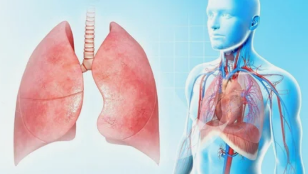Osteochondrosis of the thoracic spine is a condition diagnosed quite frequently. Statistics show that it accounts for about 40% of all diseases of the musculoskeletal system. In the early stages, a person for a long period of time may not be aware of his or her pathology.
Over time, he develops serious painful sensations, located in the thoracic spine. If you do not start the full treatment in a timely manner, there is a possibility of serious complications. The greatest danger is respiratory disorder.
Classification

Osteochondrosis of the thoracic spine is a very common disease in elderly patients. If you do not start full therapy in a timely manner, there is a possibility of serious complications.
Before starting treatment, the doctor needs to accurately classify the nature of the condition. It can be:
- Dorsago - painful sensations arise from impulses that occasionally appear in the chest. This discomfort usually starts after a long stay in the same position. A person faces difficulty breathing, while practically unable to perform any action with the head. If he can move, the pain pierces the entire spine.
- Back pain is a condition in which prolonged pain attacks occur. On average, they can last up to those weeks. This condition usually occurs due to severe damage to the intervertebral discs. During an exacerbation, you must lead an inactive lifestyle and refuse any activity. The pain increases significantly at night.
Causes of pathology
Osteochondrosis of the thoracic spine can occur in absolutely anyone and at any age.

However, the following groups of people are most at risk:
- Leading an inactive lifestyle. If you don't play sports, metabolic processes are disrupted. Because of them, the human spine begins to accumulate deposits that begin to tighten nerve endings. The discomfort increases significantly with the degree of degenerative destruction.
- Excess weight - each extra kilogram carries an additional load on the spine. The greater your weight, the heavier the thoracic spine becomes.
- Smokers - because of cigarettes, blood circulation in the body is interrupted, so the tissues of the spine do not receive enough useful elements.
- Leading a very active lifestyle. Especially often the thoracic spine suffers from frequent weightlifting.
- Various posture disorders. A curved spine is not able to properly distribute the load, which causes the thoracic region to suffer.
Demonstrations
The initial stage of osteochondrosis of the thoracic spine is characterized by an extremely long period. For a long time, the person may not notice any painful sensation. This is where the danger of pathology lies, since only in the first stage is it actively treatable.
In most cases, the development of osteochondrosis can be recognized by the following manifestations:
- Tightening of the back muscle corset;
- Uncomfortable pain located between the shoulder blades;
- Sensation of increased pressure in the chest area;
- Pain that occurs during palpation of the spinous processes;
- Pain that can radiate to other parts of the body.

A person with osteochondrosis of the thoracic spine usually has limited mobility in the morning. Crunching can also occur in certain parts of the sternum.
Often, a person is faced with numbness in the limbs, their posture starts to deteriorate quickly - this is due to excessive tension in the muscle tissue. In addition, sharp and sharp pain may occur, located in the intercostal spaces.
So far, official medicine has been unable to find effective ways to restore damaged intervertebral discs, so it is imperative to contact a chiropractor. Responsibly approach the choice of a specialist, as any wrong move can cause serious complications.
Treatment methods
Before starting treatment of osteochondrosis of the thoracic spine, a broad diagnosis is necessary. With its help, it is possible to accurately determine the location of the degenerative process, due to which a more effective and high-quality treatment can be provided. Note that only your doctor can prescribe medication. There are a large number of different drugs that differ in their principles of action.
First, pain medications - steroidal anti-inflammatory drugs will be prescribed. They interrupt the production of arousal mediators, due to which the person begins to feel much better.
Note that the patient must be under constant supervision by the attending physician during treatment.
To obtain the maximum effect from the treatment of osteochondrosis of the thoracic spine, therapy should be performed in combination. You should not limit yourself to drugs. Treatment must be completed with physical therapy and sports activities.
Medication

Drug therapy is of the utmost importance in the treatment of osteochondrosis of the thoracic spine. With the help of various medications, it is possible to stop painful sensations as quickly as possible.
It is also recommended to rest on the bed during recovery. Be sure to consult a qualified healthcare professional who can prescribe a safe and highly effective treatment regimen for you.
In general, the treatment of breast osteochondrosis includes the use of the following medications:
- Analgesics - allow you to quickly stop acute pain syndrome. It also prevents the development of failures in the respiratory system, which often cause complications;
- Anti-spasm drugs;
- Vitamin B-based vitamin preparations. They normalize metabolic processes and prevent degenerative changes.
Effective exercise
Special physical exercises are capable of dealing with the manifestations of osteochondrosis of the chest. They must be carried out regularly - this is the only way to achieve meaningful results with the approaches.
Remember that, before starting this treatment, you should consult an experienced specialist. It will tell you which complexes are best for you. Even breathing exercises with osteochondrosis of the thoracic region have a positive effect on the person's well-being.
The following exercises should be done:
- Plank - lie on the floor, crawl to the wall. Throw your legs against the wall so that they are parallel to it. Sew in a similar position for 1. 5 minutes to start. Each subsequent time, the number of approaches can be increased.
- Hang on a horizontal bar regularly. This will help you to adjust the spaces between the intervertebral discs, making you feel much better.
- Lie on your back with your legs as close to your chest as possible and stay in this position for a few seconds. This posture can relieve tension in the spine muscles, thus relieving pain.
For a more successful treatment of osteochondrosis of the thoracic region, it is essential to practice physical education. It is best to go to the clinic for exercise therapy, where you will do everything under your doctor's supervision. Be extremely careful when playing sports. Any wrong movement can easily cause injury.
Manual therapy
Manual therapy is a unique method of influencing a person's back, in which the chest area completely eliminates painful sensations. With the correct and regular approach, you will be able to completely get rid of painful sensations, tensions.
In addition, manual therapy contributes to the complete restoration of blood circulation. The active components start to spread quickly through the tissues, after which the person feels much better.
Massages
Massage is a method of influence in which the doctor activates metabolic processes with his hands. It can be performed both at home and in the hospital.

Massage movements achieve the following results:
- Eliminates the increase in muscle tone;
- Strengthens intervertebral discs;
- Accelerates the start of full recovery;
- Promotes the improvement of metabolic processes.
Physiotherapy
Various physiotherapeutic procedures help to deal with the manifestations of osteochondrosis of the chest.
They not only combat painful sensations, but also contribute to the normalization of internal processes. The most popular at the moment are the following procedures:
- Plasma injections. Part of the blood is taken from a person, from which the plasma is separated. It is injected in its pure form directly into the tissues of the spine, so it is possible to get rid of painful sensations.
- The suction cup massage is a kind of vacuum effect on the body, which is able to relieve pain and increase muscle tone in a short time.
- Magnetotherapy - exposure of the spine to a magnetic field. The procedure allows to stop the degenerative process and improve the metabolic processes. In addition, it relieves swelling and inflammation.
- Alliterapy is an innovative treatment that uses bees. The insect should sting the person directly in the affected area. This initiates metabolic processes, accelerates the removal of toxins and toxins.
- Healing with mud. This helps to nourish the spine with beneficial substances that prevent the development of degenerative changes in the human body.
- Spinal block - the use of special injections that relieve pain. Remember that these drugs must be used during the course.
What can be confused with osteochondrosis of the chest?

Osteochondrosis of the thoracic spine is a disease whose manifestations can be easily confused with several other diseases. Your symptoms may be similar to:
- Angina pectoris and heart attack. However, the patient's cardiogram is normal and the use of drugs to normalize blood pressure does not bring any results;
- Renal colic, appendicitis or cholecystitis;
- Diseases of the mammary glands;
- Ulcer, gastritis and colitis;
- Inflammation of the lungs.
Prevention of thoracic spine osteochondrosis
Thoracic osteochondrosis is a dangerous disease that significantly reduces anyone's quality of life. If you start adhering to preventive measures in a timely manner, the likelihood of complications will decrease significantly.
Many doctors strongly recommend following these tips:
- If you work on the computer for a long time, get up from the table every hour and do a little warm-up. This will help to normalize blood circulation and prevent stagnation.
- Keep your back warm at all times. So, give up cold bathing and short clothes. Always keep it warm.
- Drink vitamin complexes regularly that restore the structure of damaged tissues.
- Position yourself horizontally for at least 30 minutes in the middle of the day. This will help to align the spine, making stress easier to deal with.
- Exercise regularly. Muscle tone has a beneficial effect on the condition of the back.

























